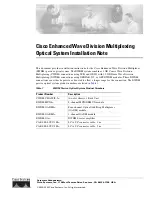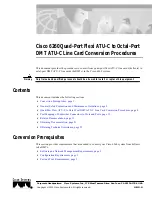
Perform the following test on an engine that has not
been run or has cooled.
1. Insert BLACK test lead into COM test lead jack.
2. Insert RED test lead into test lead jack.
3. Disconnect the wiring harness from the
temperature sensor. Refer to your vehicle service
manual for the location of the specific temperature
sensor you wish to test.
The Intake Air Temperature Sensor needs to be
removed for testing, all other temperature sensors
can remain on the vehicle for testing.
4. Add the alligator clips and connect the RED clip
to either pin on the Intake Air Temperature Sensor.
5. Connect the BLACK clip to the remaining pin.
6. Turn meters range selector to largest Ω range,
decrease to the next lower range until the appropriate
range is found. View and record the results.
7. Heat up the sensor, the best method is to use a
hair dryer or heat gun. Do not use open flame to
conduct this test as some sensors are made of
plastic. Hot water can be used if the sensor has a
sealed temperature probe. If wires are exposed
liquids should be avoided. Heat up sensor, view and
record the smallest reading displayed as the sensor
is heated.
8. When the test is completed, disconnect the meter
and reconnect the sensor to the wiring harness.
For the following test the engine should be warmed
up. Let the engine idle until it’s close to operating
temperature. Feel the upper radiator hose, it should
be warm, not necessarily hot, (be cautious).
1. Turn the engine off with the ignition key in the
off position.
2. Disconnect the wiring harness from the sensor,
leave the sensor mounted in the car.
3. Reconnect the meter test clips and view and
record the readings from the display.
A good temperature sensors resistance, with the
engine hot, should be a minimum of 350Ω less than
the reading when the engine was cold or resistance
should fall within manufacturer’s specifications.
A bad temperature sensors resistance will be
unchanged meaning an open or a short circuit.
Hall Effect Sensor
A Hall Effect sensor is a transducer that varies its
output voltage in response to a magnetic field. Hall
Effect sensors are used for proximity switching,
positioning, speed detection, and current sensing
applications. These sensors are used whenever the
vehicle ECU needs to know speed and position of a
rotating object. Examples of use are ignition
ENGINE SENSORS TESTS CONT.
ƱⅤ
Ʌ
°
systems to determine camshaft and crankshaft
position. This enables the ECU to know the
optimum time to fire the ignition coil, and turn on the
fuel injectors. This test checks for proper switching
action in any Hall Effect sensor, Ignition, RPM,
Crankshaft, etc..
Refer to your service manual for the best procedure
for your specific sensor. Some can stay in the
vehicle for testing. The following will be for testing
the sensor in the vehicle.
1. Insert BLACK test lead into COM test lead jack
2. Insert RED test lead into test lead jack.
3. Add the alligator clip to the BLACK probe and
clip it to the Negative (-) post on the battery.
4. Turn the meters range selector to 20V DC.
5. Turn the ignition key on, KOEO.
6. Touch the RED test probe to the three pins of
the sensor. Find the Signal, Supply, and Ground
Pins. Back probing may be necessary to avoid
piercing the wiring.
• Ground reading should be the same voltage as
the ground.
• Supply wire reading should be the same voltage
as the input source.
• Signal wire reading should be 0 or the same
voltage as the input source. This will cycle or toggle
high and low as the shutter rotates.
7. Slide a flat blade of iron or magnetic steel between
sensor and magnet or have a helper crank the
engine and watch the meter display. Record the
results and compare to manufacturer’s specifications.
• A good sensors meter voltage will toggles from as
steel blade is inserted and removed.
• A bad sensors meters voltage will have no change
as steel blade is inserted and removed.
Fuses/Switches
This test checks to see if a switch Opens and
Closes properly and if a fuse is blown.
1. Insert BLACK test lead into COM test lead jack.
2. Insert RED test lead into test lead jack.
3. Turn meter range selector to function.
4. Add alligator clips and connect BLACK clip to
one side of switch.
5. Connect RED clip to other side of switch.
6. Listen for a tone, if you hear a tone he switch is
closed. If you don’t hear tone the switch is open.
7. Flip the switch on and off, listen for the tone. The
tone should react as you flip the switch on and off.
To test fuses touch the RED and BLACK test leads
to opposite ends of the fuse, listen for tone.
ƱⅤ
Ʌ
°
FUSE/SWITCH/SOLENOID TESTS
ƱⅤ
Ʌ
°


































